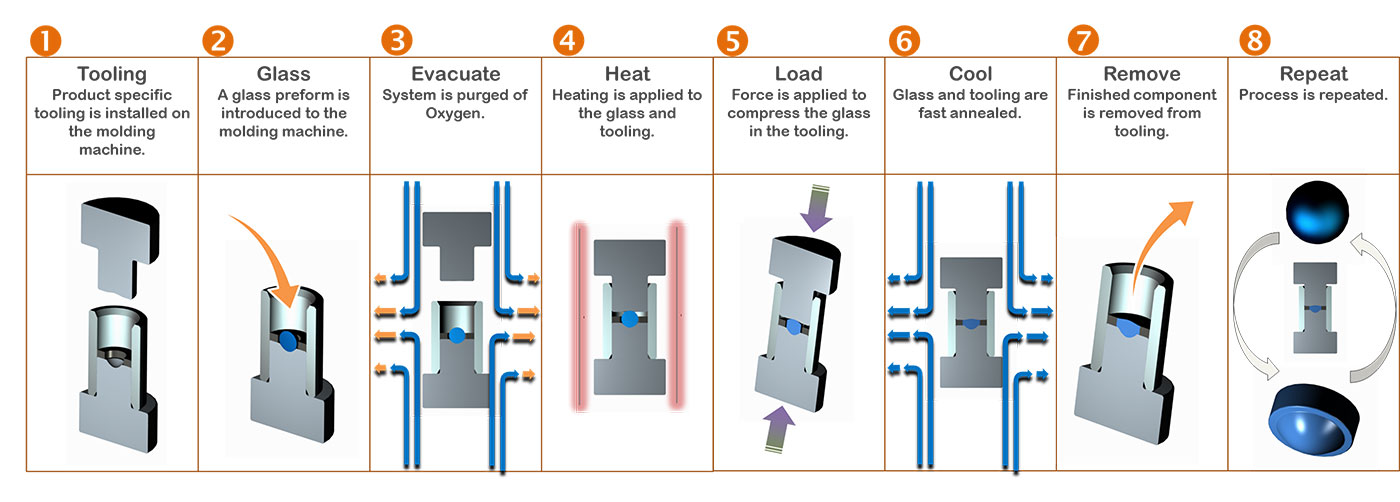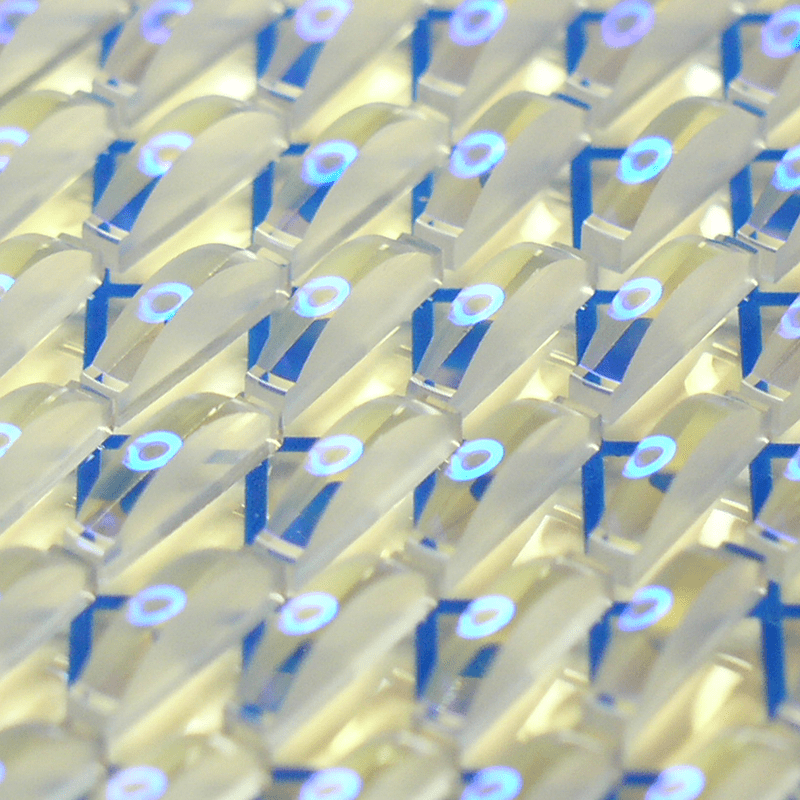Precision molding of visible and infrared glasses
Aspheric Lenses and Freeform Elements up to 52mm in size
Options for low birefringence molded lenses, and lenses molded into metal holders
Overview
LightPath’s glass molding technology has enabled high volume production of aspheric optics while maintaining the highest quality at an affordable price. Molding is the most consistent and economical way to produce aspheres in large volumes, and LightPath has perfected this method to offer the most precise aspheric lens available. LightPath offers standard and custom-made lenses, all designed by our expert optical design engineers.
LightPath’s unique molding process allows us to custom manufacture lenses based on specific requirements. We can provide lenses in a number of different form factors from simple aspheric lenses to lens arrays, and can even mold lenses directly into metal housings, eliminating the need to use epoxy to mount the lens to your optical system. Some of LightPath’s advanced lens molding capabilities include:
Lens Arrays, Anamorphic Lenses, Insert Molding (molded into a metal holder), Cylindrical Metal Holders, Square Holders, T-Holders, Custom Holders, Freeform Optics
Typical Tolerances
| Parameter | Typical Tolerance |
|---|---|
| Focal Length |
± 1% |
| Center Thickness (CT) |
± 0.025 mm |
| Outer Diameter (OD) |
± 0.015 mm |
| Wedge |
4 arcmin |
| Power/Irregularity |
3/1 fringes |
| Surface Roughness |
15nm |
| Surface Quality (scratch/dig) |
40/20 |
| Wave Front Error (RMS) |
Diffraction Limited |
LightPath has a catalog of over 100 different molded lenses in a variety of different shapes and sizes and can mold custom lenses as large as 52mm in diameter.
Our molded aspheric lenses are available with numerical apertures ranging from 0.15 to over 0.80. Applications that would use a low numerical aperture include bar code scanners, surveying instruments, and small weapons sights. High numerical aperture applications include telecommunications and industrial printing.
A History of Molding
The power of using aspheric lenses has been known for several centuries, starting with the formulas invented by Renee Descartes in the early 1600s. Although it was known that aspheric lenses had major advantages over their spherical counterparts, the cost and complexity of manufacturing them has limited their use in commercial and scientific applications.
In the last fifty years, new manufacturing methods have been developed that allow high volume, cost effective production of precision aspheric surfaces. Some examples of these methods include diamond turned aspheric optics and compression molded glass aspheric lenses. While diamond turning can produce very good quality aspheric lenses in small quantities, molding is the only true method for low priced glass aspherics for high volume applications.
Advantages of Aspheres
Traditional spherical lenses have a simple shape that can be described as an arc of a circle and can be specified using only a radius of curvature. Although these lenses are simple to manufacture and inexpensive to use, they suffer in performance due to a phenomenon called spherical aberration. This inherent defect is due to the fact that a spherical shape is not the ideal shape for a focusing or collimating lens to be. The ideal case is a more complex shape that is typically defined using a radius of curvature, a parabolic term (conic), and several high order coefficients.
The complex shape of aspheric lenses allows for correction of spherical aberration. This provides better quality collimated beams for collimating applications, a smaller spot size for focusing applications, and better image quality for imaging applications. In fact, in many cases just a single aspheric lens can take the place of several conventional spherical lenses, leading to a lighter, more compact, less expensive, and better performing optical system. Aspheres are now a viable design option for many applications.
LightPath Technologies has over 25 years of experience in molding high precision glass aspheric lenses for the industrial, scientific, communications, medical, and defense markets.

Figure 1:
Comparison of spot size between conventional spherical optic and aspheric optic. (8mm input beam, 8mm EFL, 780nm)
Spherical Lens: 667μm RMS spot size
Inside Out Understanding of Molding
LightPath utilizes a process called compression molding to create precision molded aspheric optics. This process utilizes precision tooling and components in a controlled environment to produce high precision optics cost effectively and in very high volumes. In glass compression molding, a glass “preform” (typically a sphere) is heated to a softening point and compressed between two precision manufactured molds to shape the lens into its final form.
LightPath’s compression molded process differs from other molded optics manufacturers because LightPath utilizes a volumetric molding method, meaning that the volume of the glass in the preform we start with will have the exact same volume of glass as the finished lens. Other manufacturers, which don’t use volumetric molding, usually require the lens to be ground down to the final diameter after the lens is shaped. Volumetric molding has several advantages over non-volumetric molding methods:
- After the lens is pressed, it is in its final shape, and there is no post-polishing necessary.
- Volumetric molding allows the outer diameter of the lens to be precisely controlled, eliminating the need to post process (edge grind) the lens to the final diameter after molding is complete.
- Eliminating the need to edge the outer diameter of the lens allows more precise control over the optical centration of the lens, leading to better system performance.
The illustration below demonstrates the basic steps in LightPath’s Precision Molded Optics Process:

In step 1, top and bottom molds are selected for the type of lens that will be molded. Each mold contains a precision-machined cavity designed to form one surface of the lens. A precision fabricated ring is placed in between the molds, which will ultimately set the final outer diameter of the lens.
In step 2, we insert the preform into the press. The preform can be in various shapes, but is typically a sphere.
In step 3, we purge the press of oxygen to enhance mold lifetime.
In step 4, we apply heat until the glass preform becomes a soft solid, capable of being reshaped.
In step 5, we apply force on the top mold to compress the molds together, and in the process reshaping the preform into the final shape of the lens.
In step 6, we cool the lens down in a controlled manner, which also anneals the lens in the process.
In step 7, the top mold is removed and the newly created lens can now be removed from the press. The lens is now fully fabricated and ready to be coated if desired.
In step 8, we repeat the same process over again to make the next lens.

Your OEM Partner
When it comes to designing optical systems it takes more than a computer to make it right.
It’s not just the design. By utilizing more than 25 years of optical component and assembly design and manufacturing experience, LightPath can provide you with a complete custom engineered optical solution. Understanding what it takes to build components and assemblies, and understanding manufacturing tolerances can make the difference between success and failure. It also can make your optical design and products more robust and cost effective.
Our engineers work with state of the art optical and mechanical tools, such as Zemax OpticsStudio for optical design, modeling and simulation, and TracePro for stray light analysis, illumination, and non-sequential ray tracing. Mechanical and complex thermal analysis is done with SolidWorks, Pro Engineer, and MSC One. Simulations can be performed and data provided to the customer throughout the design phase of a custom component or assembly.
LightPath is an optical solutions company providing a broad range of expertise and know-how for solving opto-mechanical problems. We can take a design from concept to finished production quickly and cost effectively. By utilizing multiple design and manufacturing facilities across three continents, including our high-volume molding facility in Zhenjiang China, LightPath produces millions of molded optics and assemblies annually.
From concept through prototyping, volume production, and global distribution, LightPath has the optical knowledge and manufacturing expertise to be your optics partner every step of the way, with over 40 engineers on staff to assist with your project.
Downloads
Contact


